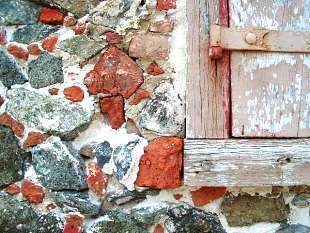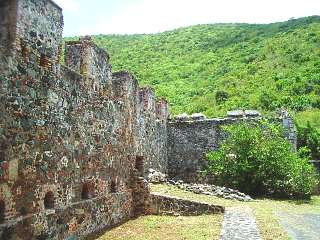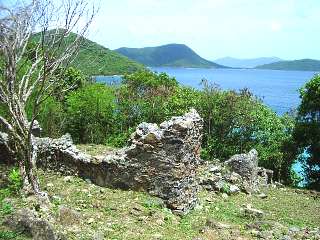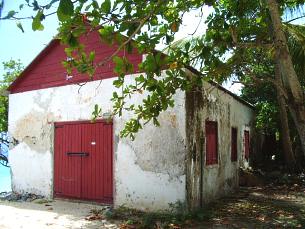Virgin Island History -
The Early Danish Era
The longest period of recorded Virgin Island history under any single nation was the Danish Colonial era. For nearly 200 years, the islands were called the Danish West Indies.

In the second half of the 17th century, France was in control of St Croix. Holland and Britain both had interests in St Thomas, and St John was claimed by the British.
In 1670, a trade treaty between Britain and Denmark was created. This was the motivating force for the Danes to form a commercial company to gain a foothold in the islands. In 1671, the Danish West India and Guinea Company was established. In 1672, the Danes sent 116 colonists to St Thomas. They found that British settlers had abandoned the island just weeks earlier.
The Danish settlers were a combination of free men and convicts brought in as laborers. As it turned out, the convicts made a poor labor force. Therefore, by the early 1700's, the Danes had created an agreement with the Brandenburg American company of Holland to import slaves from West Africa.
The ensuing years of Virgin Island history saw a boom in the development of plantations. The primary crop was sugar cane. Tobacco, cotton, indigo, and other crops were also grown.

Although there were few settlers on St John, Britain claimed the island. When Danes began encroaching on St John in the 1680's, the English on nearby Tortola protested.
In 1718 The Danes established their first permanent St John settlement at Coral Bay. A British warship was quickly dispatched to St John, but the Danes refused to quit the island. A period of tense negotiations followed. Ultimately, however, the British relented, not wishing to resort to force to oppose the Danish settlement.
Still, there were repeated disputes between the British and the Danes for many years concerning control of the island. It wasn't until 1762 that the British finally relinquished all claims to St John.
Meanwhile, in 1733, the Danish West India Company had purchased St Croix from France, solidifying the Danish hold on the Virgin Islands. They rapidly sent more Danish settlers to St Croix. They wisely also encouraged settlers from other European countries, which resulted in increased development and wealth.
Virgin Island History -
Pirates and Slavery in the Danish Era

In the late 1600s and
early 1700's, the Danish Governors on St Thomas encouraged pirates to do business on the island. They believed that this was a way to bring in much-needed cash while increasing trade. They
also may have been trying to use the pirates to ward off the dreaded Spanish.
This was the period in Virgin Island history when infamous characters like
Edward Teach (Blackbeard), Bluebeard, and Captain Kidd found safe harbor in St Thomas.
At this period in the history of the Virgin Islands, there were at least five times as many slaves as non-slaves. Because owners feared rebellion, they made conditions for their slaves unusually harsh. Punishments for misbehavior were incredibly brutal.
Not surprisingly, this led to major revolts. In 1733, there was a violent revolt on St John. Most of the plantation owners on the island and many slaves were killed. Many of the plantations were also destroyed.
The rebellion lasted seven months. It was finally put down when French and Swiss soldiers arrived on a ship from the nearby island of Martinique. Many of the slaves committed suicide rather than be forced back into slavery or face the punishments for rebellion.
Even after this revolt, the slave trade continued full force. By the mid-1700s, the increase in settlement combined with the exploding slave trade had led to a virtual blanketing of the Virgin Islands in plantations.
There were over 100 sugar plantations on St Thomas and a similar number on St John. St Croix had become one of the richest islands in the Caribbean from its sugar, molasses, rum, and slave trade.
Virgin Island History -
Post - Slavery in the Danish Era

In 1848, slaves and free Blacks on St Croix left the plantations. They entered the capital at Christiansted to protest, demanding an end to slavery.
The Danish Governor, Peter Von Scholten, had already been lobbying the Danish Crown to end slavery in the islands. He finally took matters into his own hands as a result of the protest.
He declared slavery in the Danish West Indies abolished on July 3rd, 1848.
As a result of abolition, many plantation owners abandoned their plantations. At the same time, sugar beets grown in Europe and America were creating a cheaper source of sugar than Caribbean sugar cane. The economy of the islands began a long decline.
In the latter half of the 19th century, there were a number of labor riots and protests in the islands. Through the early years of the 20th century, the social and economic fortunes of the islands continued to decline.
Virgin Island History -
The End of Danish Rule
After the outbreak of World War I, the United States took an interest in the region, fearing German infiltration in the Caribbean. In 1917, the U.S. purchased the Danish West Indies for $25 million in gold. This transaction established the U.S. Virgin Islands and ended the era of Danish rule.
Return from Virgin Island History - The Danish Era to Homepage




